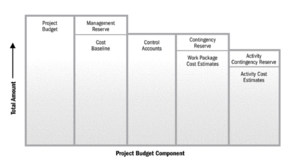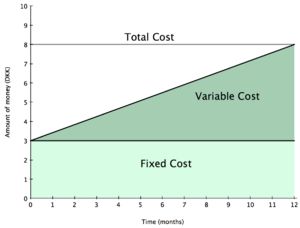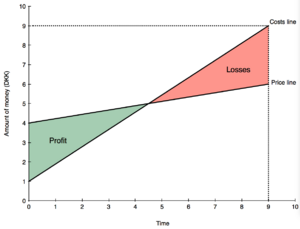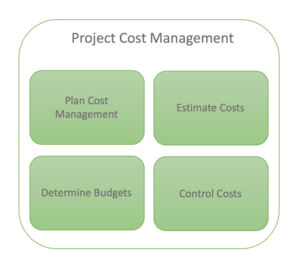Project Management: Cost vs. Price
(→Application to Project Management) |
(→Application to Project Management) |
||
| Line 40: | Line 40: | ||
With the major objective of keeping the costs according to the cost baseline it is needed to monitor them during the course of the project. This '''cost control''' process results in five crucial outcomes to the well-functioning of a project: work performance information, cost forecasts, change requests, project management plan updates and project documents updates. The techniques and mathematical models utilized to achieve these outcomes are the expert judgement, data analysis, to-complete performance index and project management information system, and as inputs all the outputs from the budget, the cost estimation and the cost plan are essential. <ref name=''PMBOK guide''> ''lProject Management: A guide to the Project Management Body of Knowledge (PMBOKguide) - page 257/270'' </ref> | With the major objective of keeping the costs according to the cost baseline it is needed to monitor them during the course of the project. This '''cost control''' process results in five crucial outcomes to the well-functioning of a project: work performance information, cost forecasts, change requests, project management plan updates and project documents updates. The techniques and mathematical models utilized to achieve these outcomes are the expert judgement, data analysis, to-complete performance index and project management information system, and as inputs all the outputs from the budget, the cost estimation and the cost plan are essential. <ref name=''PMBOK guide''> ''lProject Management: A guide to the Project Management Body of Knowledge (PMBOKguide) - page 257/270'' </ref> | ||
| + | |||
| + | |||
| + | |||
| + | |||
| + | |||
Revision as of 15:44, 20 February 2019
Contents |
Abstract
Associated to every project, however small it may be, there are always costs associated when trying to manage the project and a price for which we want to sell it. This article will present a review of how cost and price can be related to project management, what is the importance of each one separately and the importance of a good relationship between these two factors. A good harmony between them might be a key of the project success and at the same time the cause for unsucess. Therefore, in this article there will be a reflection about how cost and price relationship can be interpreted and support a good decision making. Decisions factors and decisions methods that a company needs to take into account when pricing a project or select which costs are avoidable and which ones are necessary, will also be explained along the article. The project's quality and profit are also two terms directly connected to the relationship between cost and price of every project, the way the customers evaluate a project's value from its price and the costs that are necessary to incur to sustain a certain quality of the outcome are also relations that will be further discussed here. [1]
Key Concepts
Cost
By definition cost is the amount of money that is spent in acquiring any good or paying for a service. There are two types of costs, the direct and indirect costs. The direct costs are related to the actual expense that they represent, the act of spending money in exchange of something, i.e. buying a software or equipment. The indirect costs are usually hidden beyond the the cost of a product or service, for instance, the cost of hiring a cleaning service to the office or even the rent.
These costs can be classified as fixed costs, where the value does not change - office rent, salary of employees or the cost of the cleaning service if we have a contract for a fixed number of hours, or can be classified as variable costs where there is a chance of the value to change, such as the office's bill of gas or electricity [2] [3]
Price
Price can be defined as the quantity of money, or a compensation that is given from one part to another in exchange of any good or service. The price that a costumer is willing to pay is directly related to the value that it attributes to the commodity or service. Of course, not every customer has the same perception of value about something, and this is the reason why the companies need to be careful when pricing their products. The process of finding a price that fits the market and it is not above nor below the customers expectation will be further discussed - Pricing Strategies [4]. The price of a product or service is not only directly related to the perception of their value, but it is also associated to the customers perception of quality of the product. The price is really sensitive to the market conditions and the - Theory of price [5] - explains how the price can be related to the relation between the supply and demand.
Profit
Defining profit is almost the same as defining a company's purpose to enter in the market. The profit is as simple as the difference between the price for what we sell what we product and the costs to produce it, i.e. the profit is the part of the money that is earned by the company when selling a product or service. For instance, let's suppose that a company spends 5DKK in producing a pencil and they sell the same pencil for 15 DKK, this action of selling the product will generate a profit of 10 DKK to the company.
Quality
According to the definition of Oxford English Dictionary, quality can be defined as "The standard of something as measured against other things of a similar kind; the degree of excellence of something.". When managing a project, to ensure the quality of the final outcome is one of the most important objectives of the manager. Quality is one high weighted factor that can distinguish a project from others of a similar kind and probably allows the project to be chosen among the others. The project's quality is directly related to its price and sometimes it is also related to the costs that were incurred to manage it - if the process was effective and efficient there were not unnecessary costs. [6]
Application to Project Management
Project Cost Management
In order to a project to be completed within the approved budget limit it is needed to plan the overall costs structure before it starts: estimating the costs, creating a budget, developing a plan of funding financing and managing, and develop a plan of costs control. The main objective of plan in advance all the processes is to make the project as the most efficient - regarding costs - as possible and so, avoid the bad use of money. The action of planning the costs is mainly concerned to the cost of the resources needed to finish the project. It also helps to making important decisions regarding all the project procedure, for instance, the number of times that the project design needs to be reviewed. [7] . Project Cost Management is simpler to develop if the project's scope is well defined since the beginning once it is easier to preview all the processes and do the detailed cost calculation, but if it is not defined or it presents a high level of uncertainty, methods of cost estimation can be more general and it is created a plan that can be easily changed. Project Cost Management consists in four steps as it is described in the figure . Each of these steps is composed by a group of specific techniques that transform the inputs, that in many cases are results from previous project planning processes, in outputs that when grouped together will define the Project Cost Management.
Planning the costs of a project consists in defining how the costs will be estimated, controlled, financed, managed and budgeted. Plan Cost Management is also where is decided which, how and how many resources are going to be applied to each process. The procedure of planning costs has as output the elaboration of a cost management plan that is obtained throughout the techniques as expert judgement, data analysis and meetings that uses inputs as organizational process assets, the enterprise environmental factors and the previous developed project management plan and project charter. [8]
Estimating costs of a project consists in building an approximation of costs of the necessary resources to complete the project.

With the major objective of keeping the costs according to the cost baseline it is needed to monitor them during the course of the project. This cost control process results in five crucial outcomes to the well-functioning of a project: work performance information, cost forecasts, change requests, project management plan updates and project documents updates. The techniques and mathematical models utilized to achieve these outcomes are the expert judgement, data analysis, to-complete performance index and project management information system, and as inputs all the outputs from the budget, the cost estimation and the cost plan are essential. [13]
Pricing the Project
Setting a price for a project is usually done by the company’s marketing department, because in order to set a good and suitable price, its needed to be aware about several factors such as, knowledge about the market demand, how the customers valorize the product, what do they value more and more important how much they are willing to pay for the product. Every company needs to define a pricing strategy – that usually makes part of the company’s strategic plan – that should be aligned with their mission and vision. Defining a pricing strategy reflects the intention of the company when selling the product to the customers i.e. the prices can be set in order to maximize the profit, to establish strong relations with the customers, to try to aggregate the maximum number of customers to the product, to only cover the costs of the production or even to build a company’s image in the market. [14]
Price/quality relationship
Customer’s perception of value of a product is directly related to the question that marketers ask when setting a price “how much are the customers willing to pay for this product?”. In fact, this is one of the most important factors of pricing. Regarding the quality of a product, it is usually seen as a proportional relationship between quality and price i.e. high prices are often seen as a synonym of high quality. The highest the level of complexity and uncertainty of the product the more dependent in this price/quality correlation the customers are. According to the authors of “Prestige-Seeking Consumer Behaviours“ the consumers can be divided into four ranked categories regarding their self-consciousness attitude to the importance of price as a factor of prestige. The four presented categories are: Hedonist & Perfectionist, Snob, Bandwagon and Veblenian. The Veblen effect – perceived conspicuous value - refers to the consumers that buy the product based on conspicuous value in order to show status, wealth and power. The Snob Effect - Perceived Unique Value – explains how this group of customers tend to buy the products that are not bought from the majority or when the products are released in the market and only few people have access to it i.e. the scarcity of the product gives a unique and expensive image to the product that leads to the increase of the demand within this group of people. The Bandwagon Effect - Perceived Social Value – expose the group of customers that intends to buy a product in order to fit into a social class and gain perceived social value. This group of people is often under pressure and demand from standards of groups memberships. The Hedonic Effect - Perceived Emotional Value – is described as a group of people that acquire a product without the intention of being accepted or show social status, but instead they buy the product with the intent of increase their level of wellbeing or to satisfy their own psychological needs.The Perfectionism Effect - Perceived Quality Value – refers to the group of customers that buy a product trusting the quality/price direct relationship and believe the brand with highest price will have a better performance than the other similar. [15]
Customer mindset and price sensitivity
As important as understand the price/quality relationship when setting a price to a product is understand how sensitive to the price, the targeted customers are and how can the marketer influence their price perception. The book “The Strategy and Tactics of Pricing” states nine effects that influence the customers and clarify how this can be achieved. According to the authors the nine effects are: reference price effect, difficult comparison effect, switching costs effect, price-quality effect, expenditure effect, end-benefit effect, shared-cost effect, fairness effect and framing effect. Reference price effect refers to the fact that the customers usually compare the price with similar products and consequently as higher the price of the reference more money the customer is willing to spend. Difficult comparison effect affirms that the customers become more sensitive to the price when they can’t find similar product to compare. Switching costs effects states that the consumers are less sensitive to the price when the product investment to switch suppliers is higher. Price-quality effect explains that customers are less sensitive to price if there is a relation between high costs and high quality. The expenditure effect affirms that consumers are more sensitive to price when the purchase represents a large piece of their budget or income. Ex-benefit effect can be divided in two parts, derived demand - the more sensitive the prices for product that contribute to the benefit, the more the customers will be sensitive to price of the final benefit, and price proportion cost – the customers are less price sensitive to the component´s price if that components share to the final benefit is small. Shared-cost effect states that the consumers are less sensitive to the price if they need to pay for themselves a small part of the final value. The fairness effect affirms that the buyers are more sensitive to the price if the product’s price is not classified as fair or reasonable. The last effect is the framing effect that states that the customers are more price sensitive if they see the purchase as a loss and not as a gain. [16]
Set-up project price
Regarding the project environment, usually there is a project that need to be done and so the responsible opens a contest where several companies can present a solution including all the project plan and the price they are asking to do the project. When assessing the company's proposals, several factors can be considered, and they depend on the mindset of who is assessing them, but the usually, the price-quality relation, the reliability of the company and the time-frame are always considered. The main objective when pricing a project is to achieve the financial goals i.e. profit. The companies always seek for an efficient price that is considered the price that stays between the price floor – the price that leads companies to losses – and price ceiling - the price for which there is no demand. Therefore, the companies aim to set the efficient price - close to the maxim price that the customers are willing to pay. The price of a project should consider three aspects: the estimated costs, the estimated time to spend and the level of expertise required to develop the project - usually it is added to this estimation a buffer between 15% and 30%. [17] There are two main issues when concurring to the position and setting the price, if the company set a price below the fair-value line – figure (figura da linha com dois produtos e linha) – the project can arise doubts, by who is assessing it, concerning the quality of the final outcome once the price reflects a part of the costs that the concurrent is willing to incur to reach the final project, and the other main issue is if the company sets a price too high i.e. above the line of fair-value, it risks to lose the position to a concurrent once they can present a better final value. But as it was said the price is a weight factor when deciding which company wins the contest, but is not the only one, and the decisions factors must be discussed and defined in advance the assessment of the alternatives. [18] [19] [20]
Limitations
As described throughout this article when managing a project, and does not matter its size or complexity, it is mandatory to plan in advance all the costs that the company is willing to incur and the final price to sell the project, even though sometimes with a high level of uncertainty is a crucial step before start to develop the project. Therefore, there are some limitations when defining the costs in advance once all techniques are based in estimations and so the final value cannot correspond to the estimation primarily done – factors are subject to several external indicators that can vary throughout the time. Still regarding the project cost management, the techniques and mathematical models that transform the inputs in outputs present a high level of complexity and even though they might be done by specialists there is a margin to fail the calculations. It is necessary to be aware that the cost estimations are the basis for develop the Project Cost Management successfully, and also to help to set the prices for the final product. Therefore, all these procedures present a high level of dependence on mathematical complex models and consequently a level of uncertainty.
References
- ↑ lProject Management: A guide to the Project Management Body of Knowledge (PMBOKguide)
- ↑ Direct and Indirect costs - https://www.businessnewsdaily.com/5498-direct-costs-indirect-costs.html
- ↑ Cost curve - https://en.wikipedia.org/wiki/Cost_curvel
- ↑ Pricing strategies - https://en.wikipedia.org/wiki/Outline_of_industrial_organization
- ↑ Theory of price - https://www.investopedia.com/terms/t/theory-of-price.asp
- ↑ Definition of quality - https://en.oxforddictionaries.com/definition/quality
- ↑ lProject Management: A guide to the Project Management Body of Knowledge (PMBOKguide) - page 233
- ↑ lProject Management: A guide to the Project Management Body of Knowledge (PMBOKguide) - page 235/239
- ↑ lProject Management: A guide to the Project Management Body of Knowledge (PMBOKguide)
- ↑ lProject Management: A guide to the Project Management Body of Knowledge (PMBOKguide) - page 240/247
- ↑ lProject Management: A guide to the Project Management Body of Knowledge (PMBOKguide)
- ↑ lProject Management: A guide to the Project Management Body of Knowledge (PMBOKguide) - page 248/256
- ↑ lProject Management: A guide to the Project Management Body of Knowledge (PMBOKguide) - page 257/270
- ↑ Pricing - https://en.wikipedia.org/wiki/Pricing
- ↑ Franck Vigneron and Lester W. Johnson. A Review and a Conceptual Framework of Prestige-Seeking Consumer Behavior
- ↑ Thomas T. Nagle, John E. Hogan, Joseph Zale. The Strategy and Tactics of Pricing - 5th edition
- ↑ Price a project - https://www.getharvest.com/resources/how-to-price-your-projects
- ↑ Franck Vigneron and Lester W. Johnson. A Review and a Conceptual Framework of Prestige-Seeking Consumer Behavior
- ↑ Thomas T. Nagle, John E. Hogan, Joseph Zale. The Strategy and Tactics of Pricing - 5th edition
- ↑ Price quality graph - http://changingminds.org/disciplines/marketing/pricing/price-quality_graph.htm
Further reading
- Project Control, Spring 2018 [1]
- Quality Control in Construction, Spring 2018 [2]
- Construction Cost Management, June 2017 [3]
- Quality Control, June 2017 [4]
- Project Quality Management, Fall 2016 [5]
- Cost Estimation Techniques for Projects, Fall 2016 [6]
- Lean Project Management, Fall 2014 [7]
Annotated bibliography
- Project Management: A guide to the Project Management Body of Knowledge (PMBOKguide) - 6th edition
Chapter 7 - This chapter, Project Cost Management, explains what is the importance to plan the costs in advance the beginning of the project, which are the components and their importance and how they are completed in order to successfully achieve the final result.
- Franck Vigneron and Lester W. Johnson. A Review and a Conceptual Framework of Prestige-Seeking Consumer Behavior
This review presents the price/quality relationship, and divide the consumers into four categories according to their intentions when buying a product and explain how each of these groups acts according to the psychological effects.
- Thomas T. Nagle, John E. Hogan, Joseph Zale. The Strategy and Tactics of Pricing - 5th edition
This book refers the several strategies and tactics to price a project and the focus on the book was to explain the sesivity of the consumers to the price. Chapter 12 - This chapter, Measurement of price sensitivity, states nine effects for which the customers have a price perception when performing a purchase i.e. the nine effects of how sensitive customers are to price variations according to their point of view of buying a product.


